Exploring Treatment Options
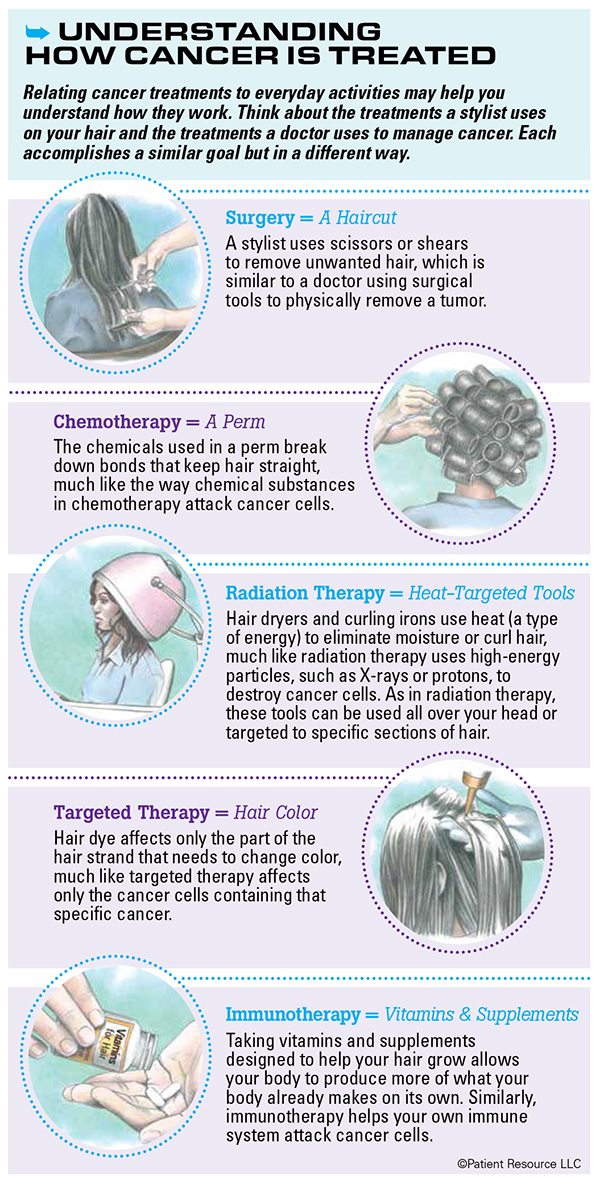
Significant progress in diagnosing and treating cancer has been made in recent years. New classes of drugs, drug strategies and combination treatments have changed how doctors approach this disease. As a result, more options are available, offering patients hope for living longer.
Your treatment plan will be based on many factors: whether you are newly diagnosed or are experiencing a recurrence; the presence of symptoms; your overall health; the aggressiveness of the cancer; and your goals of treatment, which often include curing the cancer, controlling tumor growth and pain, and improving your quality of life. Your doctor will look at the characteristics that make your diagnosis unique, such as your staging and pathology results, the presence of biomarkers and the potential response to certain types of treatment.
Depending on your diagnosis, it may benefit you to seek out a specialist, especially if you have a rare type of cancer or one that does not have many available treatments. Specialists are typically leaders in research and more aware of cutting-edge treatments, including clinical trials. If a specialist is not nearby, you can request that one consult with your local oncologist. The second opinion is valuable, and it is wise to gather all the information you can.
The goal is for you to receive the best level of care possible. For that to happen, the treatment plan you start with may change if test results or symptoms indicate the need. Your doctor will monitor you regularly, and you will be responsible for communicating with your health care team and keeping follow-up appointments.
Treatment Types
Treatment plans often include one or more approaches.
Surgery is the primary method for treating a solid tumor. Removing it may offer the best chance of controlling the disease and preventing it from spreading, especially for people with early-stage disease. Your doctor may also perform a surgical procedure to stage the cancer or to relieve or prevent symptoms that may occur later.
Radiation therapy uses high-energy radiation to destroy cancer cells and shrink tumors. Other uses include targeting specific parts of the body for localized disease or bone pain, and giving it prior to a stem cell transplant. It may also be delivered as neoadjuvant therapy to shrink tumors before surgery and as adjuvant therapy to kill remaining cancer cells after surgery.
External-beam radiation therapy (EBRT) delivers radiation from a machine outside the body (see Figure 1). Types of EBRT include three-dimensional conformal radiation therapy, stereotactic body radiotherapy and intensity-modulated radiation therapy. A newer type of radiation called proton therapy uses charged particles called protons.
Brachytherapy, also called internal radiation therapy, uses a radioactive substance sealed in needles, seeds, wires or catheters placed directly into or near the cancer. Radiation may be delivered at a high dose rate over several hours or at a low dose rate over a longer period.
Alpha emitter radiation therapy uses radiopharmaceuticals, which are drugs that give off targeted radiation, to suppress cancer in the bones and reduce pain.
Systemic therapy may be given through an IV into a vein or a port in your body. It may also be given as an injection (shot), subcutaneously (injection under the skin) or orally as a pill or liquid. The goal is to destroy microscopic cancer cells thought to be hiding in other organs of the body (such as the liver, lungs, bones), and these treatments therefore lower the risk of future metastatic cancer.
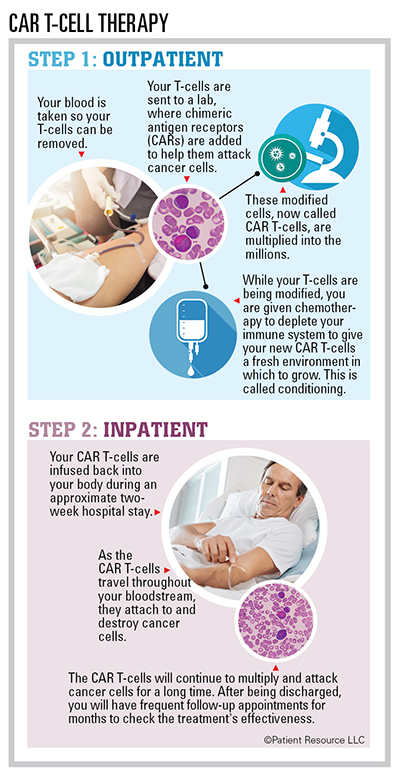
Chemotherapy uses drugs to kill rapidly multiplying cells throughout the body. It is typically delivered in cycles, with treatment periods followed by rest periods to give your body time to recover. Chemotherapy may be used alone or with other drug therapies and forms of treatment, such as stem cell transplantation or chimeric antigen receptor (CAR) T-cell therapy, a type of immunotherapy.
Immunotherapy stimulates your immune system to find and attack cancer. This strategy trains the immune system to respond to cancer, giving it the potential for a response that can extend beyond the end of treatment. Different types of immunotherapy approved to treat the types of cancer are discussed in this guide. Some are used alone or with other therapies.
Targeted therapy kills cancer cells or stops the progression of disease. The drugs travel throughout the body via the bloodstream looking for specific proteins and tissue environments to block cancer cell signals and restrict the growth and spread of cancer. This therapy targets genes, proteins or other substances that support the tumor. Some of these drugs may be given alone or in combination with other drug therapies. Different types of targeted therapy may be available depending on your diagnosis.
Hormone (endocrine) therapy blocks the stimulating effect of hormones. It slows or stops the growth of cancer and is used because hormones that occur naturally in the body promote the growth of some cancers. Both drug treatment and surgery can function as hormone therapy.
Corticosteroids are drugs that can help reduce inflammation and may offer other benefits. They can be used alone or in combination with other drug therapies.
Bone-modifying drugs can treat bone problems caused by some cancers and therapies. These drugs can also prevent further bone damage from occurring.
Active surveillance, also called watchful waiting or watch and wait, may be recommended for very slow-growing cancers. Postponing treatment allows you to avoid potential treatment side effects for as long as possible while your doctor closely monitors you for signs that active treatment is necessary. Regularly scheduled imaging tests and blood tests will be crucial. Treatment should begin as soon as cancer progression occurs.
Stem cell transplantation, also known as bone marrow transplantation, is an infusion of healthy blood stem cells into the body. The two main types are autologous (auto) and allogeneic (allo) transplants. An auto transplant uses the patient’s own stem cells, which are collected, filtered, processed and frozen. Chemotherapy and sometimes full-body radiation (conditioning) are given to destroy cancer cells. The reserved stem cells are thawed and infused back into the patient’s body. An allo transplant uses stem cells donated by a family member or unrelated donor. It may be used for patients with a high risk of relapse, those who are not responding fully to other treatments or those who have relapsed disease.
Radiofrequency ablation (RFA) may be used to treat a tumor that is inoperable or when surgery is not an option for another reason. The minimally-invasive, image-guided procedure kills cancer cells by inserting a needle through the skin directly into the tumor and running electrical current through it to subject the tumor to extreme temperatures. Other types of therapy include microwave ablation (MWA) and cryoablation, also called cryosurgery or cryotherapy.
Plasmapheresis may be used if the blood becomes too thick. It uses a machine to filter plasma out of the blood.
Clinical trials are medical research studies that may offer the opportunity to try an innovative treatment before it is widely available.
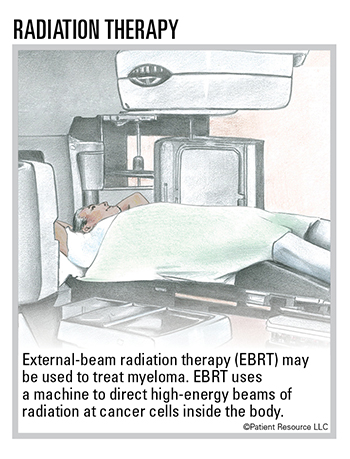
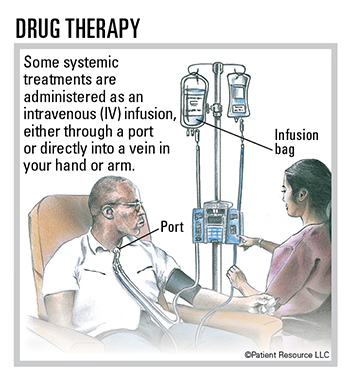
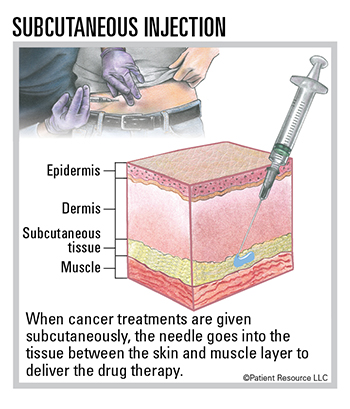
Terms to know
You will hear many new words and phrases. These definitions will help.
Adjuvant therapy: Additional cancer treatment given after the primary treatment to lower the risk that the cancer will come back. Adjuvant therapy may include chemotherapy, radiation therapy, hormone therapy, targeted therapy or biological therapy.
First-line therapy: The first treatment used.
Local treatment: Directed to a specific organ or limited area of the body and includes surgery, radiation therapy and topical therapy (a lotion or cream that is applied to the skin).
Neoadjuvant therapy: Treatment given as a first step to shrink a tumor before the main treatment, which is usually surgery, is given. Other examples of neoadjuvant therapy include chemotherapy, radiation therapy and hormone therapy. It is a type of induction therapy.
Second-line therapy: Given when the first-line therapy does not work or is no longer effective.
Standard of care: The best treatment known for the type and stage of cancer you have.
Systemic treatment: Typically drug therapies, such as chemotherapy, hormone therapy, immunotherapy and targeted therapy, that travels throughout the body.


